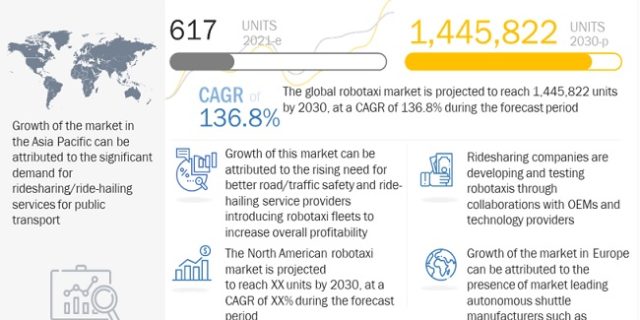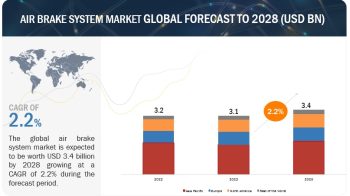
The global Robotaxi Market size is projected to grow from 617 units in 2021 to 1,445,822 units by 2030, at a CAGR of 136.8%. Factors such as The rising concerns over road safety, emissions, and the increasing demand for ride-hailing services have led to the growth of the market. Autonomous vehicles also help in optimizing cost to the fleet operator. Newer business models like mobility as a service would provide another sustainable and profitable revenue stream in the future.
Browse in-depth TOC on “Robotaxi Market“
159 – Tables
64 – Figures
193 – Pages
Download PDF Brochure @ https://www.marketsandmarkets.com/pdfdownloadNew.asp?id=132098403
Market Dynamics:
Driver: Need for road safety and traffic control
According to the NHTSA, globally, approximately 94% car accidents occur due to human error every day. As stated by Waymo in 2020, approximately 1.4 million people die every year in road accidents around the world. As per the MIT Energy Initiative’s Mobility of the Future study in 2020, approximately 40,000 lives were lost in the US in 2019 due to road accidents. These behavioral errors can be reduced if technology takes charge of human activities such as driving. This is expected to lead to a reduction in owned vehicles on roads, decreasing the number of cars in cities worldwide. Thus, this is expected to ease traffic congestion and increase in efficiency in traffic control.
Opportunity: Government support to drive the market
The race to deploy autonomous vehicles, especially in developed nations, has caught the attention of public policy makers in autonomous transportation and its potential impact. Governments of various countries have already loosened legal hindrances to undertake the testing of self-driving vehicles. The Ministry of Transport and Communications of Finland has gone a step ahead as it has prepared a legal structure for testing autonomous vehicles. Similarly, many other jurisdictions in countries such as Austria, France, Netherlands, UK, and the US are also following suit. For instance, in 2020, two new commercial programs were introduced by the California Public Utilities Commission (CPUC) which are expected to enable companies to test their robotaxi’s for commercial ride-hailing services.
Request Free Sample Report @ https://www.marketsandmarkets.com/requestsampleNew.asp?id=132098403
Electric propulsion is estimated to account for the largest market size during the forecast period
Rising emission concerns has led to the demand for fuel efficient vehicles. Robotaxis would not just offer robotic assistance but usher in an era of fuel efficiency and carbon-free emissions. The collaboration between Volvo and Uber is expected to introduce self-driving cars in the mid-size luxury segment by 2021—50% of which would be fully-electric cars. By 2030, two-third of the global population would reside in urban areas. Daimler is working with Bosch to develop self-driving electric cars in Germany that could be on the road by early 2020s. Full-electric robotaxis are already in demand due to stringency in worldwide government regulations for an emission-free environment. The joint venture between Volvo and Baidu for electric self-driving taxis in China is an example of an ecofriendly and advanced technical approach. Likewise, the partnership between BMW and Daimler has raked in investments worth USD 1.13 billion in autonomous electric cars.
Key Market Players
The global The Robotaxi Market is dominated by global players such as Waymo (US), Cruise LLC (US), Baidu (China), AutoX (China), and Tesla (US). These companies develop new products, adopt expansion strategies, and undertake collaborations, partnerships, and mergers & acquisitions to gain traction in the high-growth Robotaxi Market.
Speak to Analyst @ https://www.marketsandmarkets.com/speaktoanalystNew.asp?id=132098403


